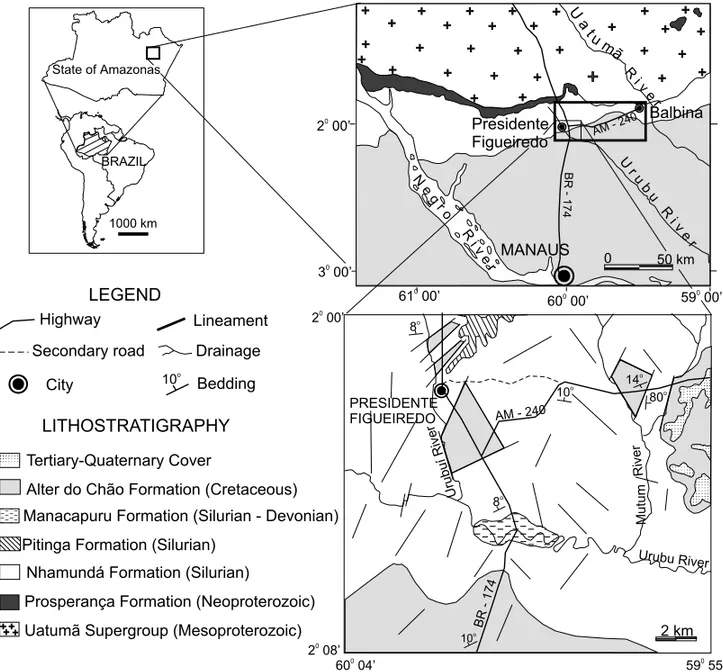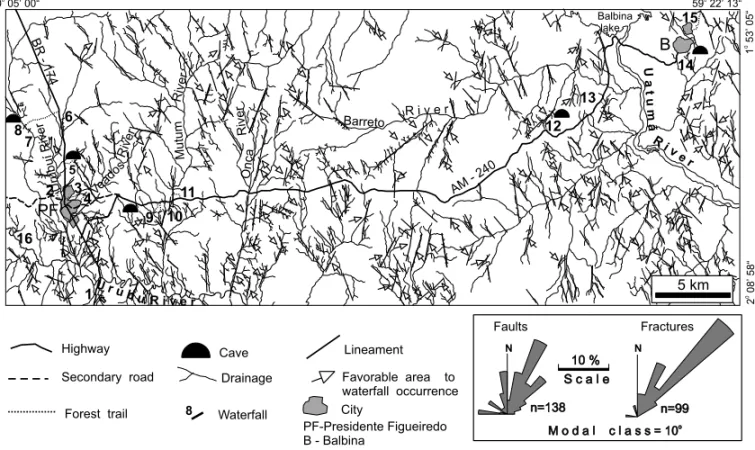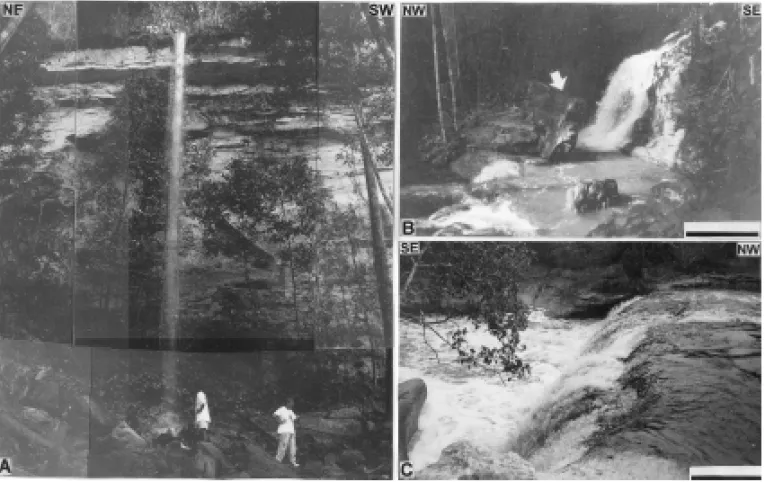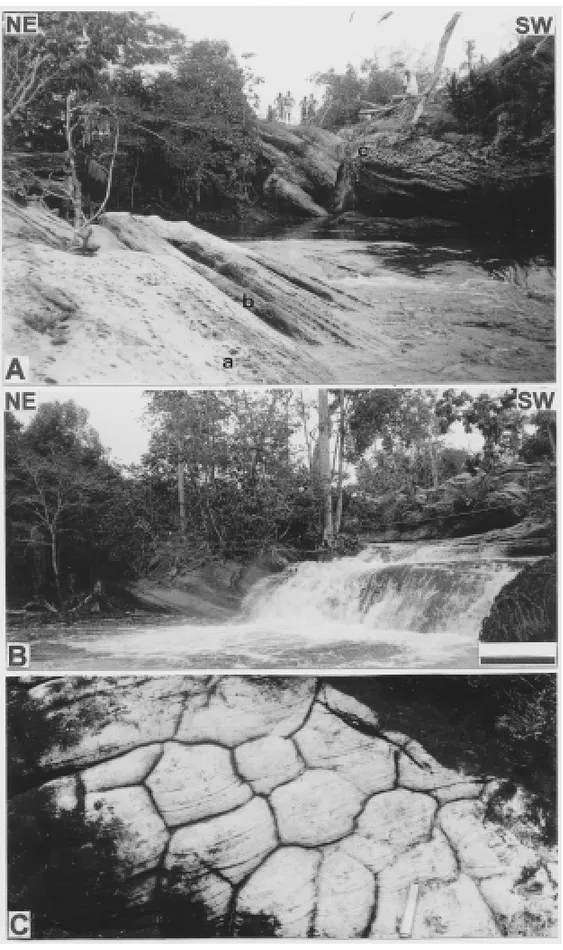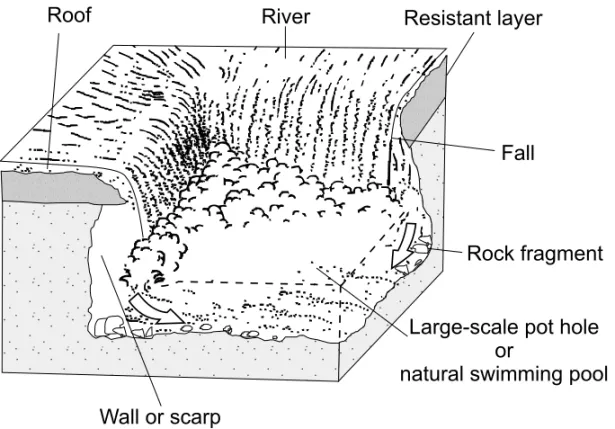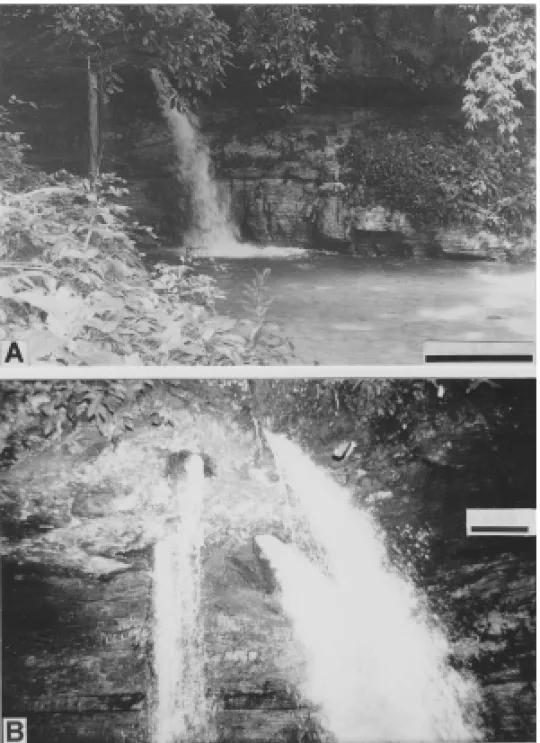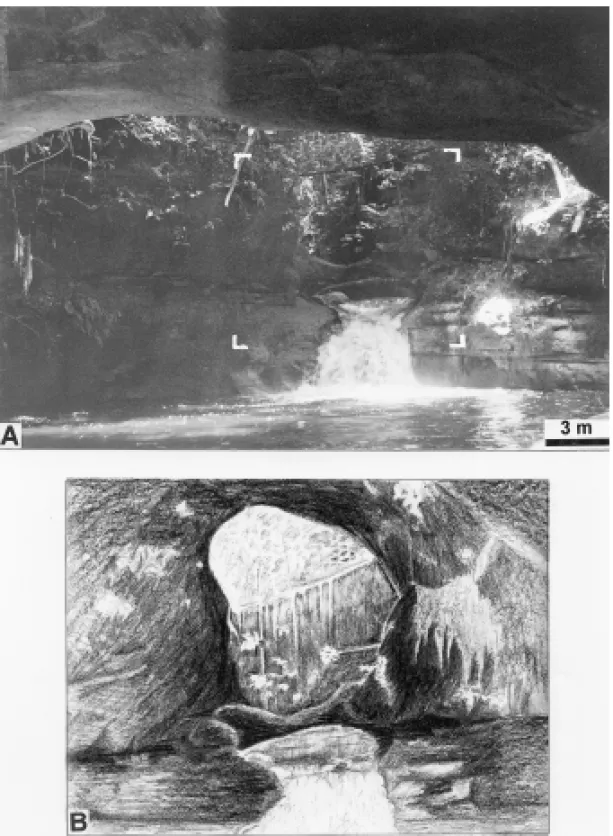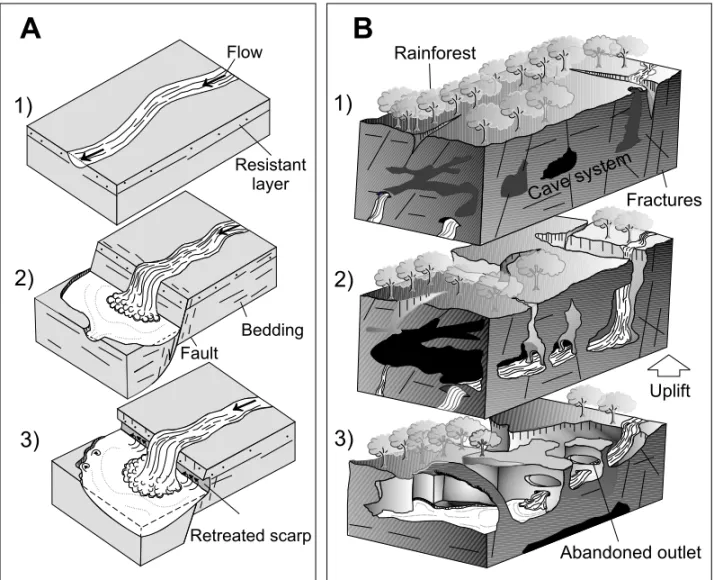AFONSO C. R. NOGUEIRA1,2 and ROSEANE R. SARGES1∗ 1Departamento de Geociências, Universidade do Amazonas, Campus Universitário
69077-000 Manaus, AM, Brasil
2Programa de Pós-graduação em Geologia Sedimentar Igc-USP Departamento de Geologia Sedimentar e Ambiental-Igc/USP
Rua do Lago, 562 – 05508-000 São Paulo, SP, Brasil
Manuscript received on August 30, 2000; accepted for publication on February 12, 2001; presented byK. Suguio
ABSTRACT
The waterfalls of the Presidente Figueiredo municipality represent a fascinating natural scenery of northeast state of Amazonas, northern Brazil. The falls, generally less than 10m high, are developed on siliciclastic rocks of the Nhamundá (Lower Silurian), and Manacapuru (Upper Silurian – Lower Devonian) formations. Morphological and structural analyses of these features indicate that most of them originated through Qua-ternary neotectonics and are installed in NE-trending normal fault escarpments. Waterfalls also developed within pseudokarstic features, but are less frequent.
The origin of the Presidente Figueiredo waterfalls probably goes back to the Neogene, when the region was submitted to laterization processes associated with a humid climate and a dense rainforest. These conditions favored the development of caves in quartzarenites of the Nhamundá Formation. During the Quaternary, the region was subjected to NE-trending normal faulting which displaced laterite layers, rivers and streams giving rise to waterfalls. These climatic and tectonic phenomena promoted intense relief dissection, as indicated by fault escarpment retreat and cave dismantlement, responsible for the present-day morphologic configuration.
Key words:waterfalls, Western Amazon, Quaternary tectonics, pseudokarst.
INTRODUCTION
The Presidente Figueiredo municipality, located about 100 km to the north of Manaus and easily accessible by the BR-174 and AM-240 highways, represents one of the major tourist attractions of the northeast state of Amazonas (Fig. 1). It is mainly due to their natural beauties represented by exuberant fauna and flora, caves, rapids and water-falls. Founded in 1981, this municipality has an area
Correspondence to: Afonso C.R. Nogueira E-mail: acrnogue@usp.br
∗CNPq undergraduate fellowship
of 24.781 km2, where the Urubu and Caverna do
Maroaga Environmental Protection Areas, Waimiri-Atroari Indigenous Reserve and most of the Uatumã Biological Reservation are located.
Presidente Figueiredo region is known as “Wa-terfallsland”, however its geological and geomor-phological settings are still little known, mainly con-cerning to the origin of their nowadays known 57 waterfalls.
and 231/61 (scale 1:100,000), planialtimetric charts (scale 1:100,000), radar images (scale 1:250,000) and aerial photographs numbers 20659 to 20669 of DNPM/CPRM (scale 1:100,000). This study al-lowed to conclude that the waterfalls, developed in quartzarenites and shales of the Nhamundá (Lower Silurian) and Manacapuru (Upper Silurian-Lower Devonian) formations, are associated to fault scarps and secondarily to pseudokarstic features.
THE PRESIDENTE FIGUEIREDO REGION
Morphologic and Litostratigraphic Setting
The Presidente Figueiredo region, located along northern border of the Amazon Basin, is included within the Amazon Sedimentary Basin Plateau (ASBP) and Rio Trombetas-Rio Negro Dissected Plateau (TNDP) (Nascimento et al. 1976, Costa et al. 1978). The ASBP, the most expressive physio-graphic feature at the north of the study area, is de-veloped on older rocks and consists of 100 to 250m high flat-topped hills (tablelands), gently-sloping valleys and low to medium drainage density. The TNDP domain constitutes a large southward gen-tly dipping planation surface, partially formed by 150-250m high ferrobauxite-capped round-topped hills. This relief is recognized by interfluvial table-lands and narrow steeply-sided valleys, forming an intensely dissected surface with medium to high drainage density.
The older lithostratigraphic units of the area are Precambrian in age (Fig. 1). The Uatumã Su-pergroup is composed by acid volcanic rocks, gran-ites and basic to intermediary dikes (Santos 1984) which, together with Prosperança Formation silici-clastic rocks, constitutes the Proterozoic basement of the northern margin of the Amazon Basin (Cunha et al. 1994, Nogueira and Soares 1996).
Three lithostratigraphic units of Trombe-tas Group have been recognized in the Presidente Figueiredo region: 1) Nhamundá Formation (Lower Silurian; Grahn 1991, 1992), that consists of fine to coarse-grained quartzarenites with cross and pla-nar beddings, and subordinated shales (Cunha et al.
1994, Nogueira et al. 1997, Soares et al. 1998); 2) Pitinga Formation (Lower to Middle Silurian; Grahn 1991, 1992), represented by shales and fine-grained sandstones with wavy bedding (Cunha et al. 1994, Nogueira et al. 1997); and 3) shales and subordi-nated sandstones of the Manacapuru Formation (Up-per Silurian to Lower Devonian; Grahn 1991, 1992, Coelho 1994), that are exposed at east-western belt outlining approximately the Urubu River valley.
The Alter do Chão Formation (Upper Creta-ceous; Dino et al. 1999), confined in grabens (Nogueira et al. 1997) or as continuous outcrops to the south of the studied area, is composed of feldspathic - kaolinitic sandstones, conglomerates and subordinated mudstones (Cunha et al. 1994, Nogueira et al. 1997).
At the top of Precambrian residual massifs and older sedimentary units occurs Tertiary-Quaternary Cover. This unit consists of Late Tertiary to Pleis-tocene mature and immature lateritic profiles and yellow latosols (Costa 1991, Horbe et al. 1997, 2000) and Quaternary colluvial and alluvial de-posits.
Hydrographical and Structural Setting
LITHOSTRATIGRAPHY
Tertiary-Quaternary Cover
Alter do Chão Formation (Cretaceous)
Manacapuru Formation (Silurian - Devonian)
Pitinga Formation (Silurian)
Nhamundá Formation (Silurian)
Prosperança Formation (Neoproterozoic)
Uatumã Supergroup (Mesoproterozoic) LEGEND City Secondary road Highway Bedding Drainage Lineament 10o
State of Amazonas
1000 km BRAZIL R i v e r N e g r o U r u b u R i v e r U a t BR -174
AM- 240
Presidente Figueiredo
Balbina
MANAUS
2 00’0
3 00’0
61 00’0
60 00’0 59 00’0
0 50 km
u mã
R i v
e r
59 55’0
2 00’0
2 08’0
60 04’0
PRESIDENTE FIGUEIREDO
Mutum
BR -174
AM - 240
2 km 10o 8o 8o 10o 80o 14o Urubuí River Urubu River River
Fig. 1 – Location and geologic map of the Presidente Figueiredo municipality and the study area. (After Schobbenhaus and Campos 1984 and Nogueira et al. 1997 modified).
The major identified-lineaments are trending preferentially to NE-SW and NW-SE, concentrated between 0◦- 40◦NE and 10◦- 50◦NW. E-W and N-S orientated lineaments are subordinated. Locally, the lineaments show romboedral-shaped patterns, formed by NE-SW and NW-SE conjugated sets, sometimes associated with right-lateral and left-lateral brittle strike-slip faults (Fig. 2).
The field surveys consisted mainly in the recog-nition of planar and linear rock structures, seeking to understand their geometry and age relationships. The commonly observed features in the waterfalls
1 3 4 5 6 7 8 9 16 10 11 12 13 14 15 R i v e r U atum ã
R i v e r Barreto On ça Mutum River River River Veados Urubu í River
R i v e r U r u
b u BR
-174
B
AM- 240
59 22’ 13“0
20 8 ’ 58 “ 0
60 05’ 00“0
15 3 ’ 05 “ 0 2 Secondary road Highway
Favorable area to waterfall occurrence
Lineament
Drainage
City Forest trail 8 Waterfall
Cave
Balbina lake
N N
n=138 n=99
M o d a l c l a s s = 10o
M o d a l c l a s s = 10o
S c a l e S c a l e 10 % 10 %
Faults Fractures
PF
PF-Presidente Figueiredo B - Balbina
5 km
Fig. 2 – A drainage and lineament map of the study area, showing favorable areas for occurrence of waterfalls (arrows). The numbers on the map correspond to the waterfalls: 1) Suframa; 2) Onça; 3) Santa Cláudia; 4) Orquídeas; 5) Arcos; 6) Lajes; 7) Araras; 8) Iracema; 9) Berro D’Agua; 10) Santuário; 11) Portal das Cachoeiras; 12) Pedra Furada; 13) Paredão; 14) Bica; 15) Suçuarana, 16) Rio Branquinho. The rose diagrams in the lower right of the map show the faults and fractures measured in the studied waterfalls.
The Nhamundá Formation, in general, exhibits subhorizontal bedding, but near the faults it can be subvertical (Figs. 1 and 4A and B). Discrete strike-slip faults trending NE-SW and NW-SE, with left and right-lateral displacements, respectively, are lo-cally observed in the Suframa, Araras and Suçuarana waterfalls. The fractures are normally straight, sometimes curvilinear, and oriented to NE and NW and secondarily N-S, dipping subvertically near the faults.
The identified mesoscale normal fault trend was extended to the NE-SW lineaments recognized on satellite images. The interception between lin-eaments and drainage traces were considered to be favorable for occurrence of waterfalls. Using this hypothesis it was possible to delineate a drainage and lineaments map, which is useful for discovery of new waterfalls (Fig. 2).
THE WATERFALLS OF PRESIDENTE FIGUEIREDO
Morphology
The waterfalls of Presidente Figueiredo region are small-scale morphologic features, in general less than 6m high and rarely more than 10m high (Ta-ble I). They are developed on thick quartzarenites layers of the Nhamundá Formation and, secondarily, on quartzarenites and mudstones of the Manacapuru Formation. The rivers entrapped within waterfalls usually flow on horizontal layers although, locally, as in the Portal das Cachoeiras, the waterfall is obse-quent (flowing against the dip) and running toward the subsequent (flowing normally to the dip) Mutum River (Fig. 4B).
Fig. 3 – General aspects of fault scarps. A) Paredão Waterfall. B) Onça Waterfall, showing a rock slice detached from the fault plain (arrow). C) Fall preceeding the Iracema Waterfall. Scale bar is 3m.
TABLE I
Main characteristics of the studied waterfalls.
W a t e r f a l l / L i t h o l o g y S t r u c t u r e / M o r p h o l o g y F e a t u r e
H e i g h t ( m ) Sandstone Mudstone Stratification Trace Scarp Honey- Pot Sink Cave Cracks
fossil comb hole hole
Araras / 8 * * *
Arcos / 1,5 * * *
Berro D’Água / 2,5 *
Bica / 4 * *
Iracema / 10 * * * * * * *
Lajes / 1,7 * * * * * *
Onça / 5 * * *
Orquídeas / 6 * * *
Paredão / 30 * * *
Pedra Furada / 6 * * * * * *
Portal das
Cachoeiras / 3 * * * * *
Santa Cláudia / 4 * * * * * *
Santuário / 15 * * *
Suçuarana / 12 * * * *
Suframa / 6 * * * *
Fig. 4 – Morphologic aspects of the Portal das Cachoeiras Waterfall. A) The subsequent behavior of the Mutum River flowing on rotate beds of the Nhamundá sandstones. The letters "a", "b" and "c" refer, respectively, the pot hole feature,Skolithos-like traces detached
(or natural swimming pool), scoured at the base of the waterfall by impact of water, enlarged by rocky fragments transported by the river (Fig. 4B); 3) roof, restricted to waterfalls with layers more resistant to erosion, which is situated at the top of waterfall; 4) and scarp (or wall), representing the fault plane more or less retreated by water erosion (Fig. 3). The main characteristics of the studied waterfalls are summa-rized in Table I.
At the bottom and margin of rivers with water-falls there are smaller pot holes (Fig. 4Aa). Some-times, they have been developed following Sko-lithos-like traces and fractures, as in the Urubuí River rapid in Presidente Figueiredo town or in the Lajes, Iracema and Portal das Cachoeiras waterfalls (Fig. 4Ab). There are also sandstones with honey-comb solution features, which sometimes confused with pot holes, besides tortoise shell-like polygonal cracks are found in Iracema, Portal das Cachoeiras and Lajes waterfalls (Figs. 4Ac and 4C). Sink hole morphology was found mainly on waterfall roof resistant layers. Its cylindrical shape, where the stream is beheaded, sometimes is tilted up to 45◦ in relation to the subhorizontal roof (Fig. 6). In Suframa and Pedra Furada waterfalls, centimetric layers of silicified-sandstone, form a positive relief on the wall of finer material with a stepped pattern (Fig. 6A).
The standard morphology of the waterfalls (Fig. 5) is suitable to the waterfalls formed in fault scarps; however, it could not be applied to the water-falls controlled by pseudokarstic relief features. The morphology of the Arcos Waterfall area is charac-terized by three quartzarenite biconvex projections, whose convexities (arches) are cylindrical with a di-ameter of 3m and length of 14m, distant themselves by 12m (Fig. 7). The central part of these biconvexi-ties forms an elliptical outlet channel with a diameter of 1 to 6m, that can be active or abandoned. The ac-tive outlet is draining the stream to form the main fall of the Arcos Waterfall. In contrast, the aban-doned outlet rises about 2,5m above the water level and, sometimes, form natural bridges on the river (Fig. 7).
Origin
Roof
River
Resistant layer
Fall
Rock fragment
Large-scale pot hole
or
natural swimming pool
Wall or scarp
Fig. 5 – Morphological elements of waterfalls (after Coltrinari 1994).
of western Amazonian would be oriented to NW-SE and NNW-SNW-SE, differently from the directions founded in the waterfalls. In addition, the NE-SW direction in this model would represent reverse or strike-slip faults. The field data from 16 outcrops are not enough to solve this incompatibility nor to adopt the above mentioned neotectonic model in this work, but apparently are sufficient to discard the as-sociation of these waterfalls with reverse faults.
The erosional action of the water, of subsidiary importance in the waterfalls originated by faults, was responsible for the headward erosion suitable for the scarp retreat, which is function of the resis-tance, thickness and fracturing degree of the layers (Alexandrowicz 1994). The mechanical fracturing is one of the most important processes for the wall degradation because it favors fast removal of blocks and rocks fragments, whose transport increase ero-sional ability of the turbulent flow. In waterfalls formed only by more resistant beds, the headward erosion is less effective, unlike those developed upon mudstone and sandstone successions. The removal of the finest material of these successions leads to
the formation of multiple stepped pattern, where the projecting parts are formed by sandstone layers (Fig. 6A).
Fig. 6 – Pedra Furada Waterfall. A) The general aspects and rock of the wall repre-sented by interbedded shales and basal stratified sandstones and massive sandstone in the top perforated by two sinks (dry period). Scale bar is 3m. B) Detail of the sinks (in plant) in flood period. Scale bar is 0,5m.
changes in the temperature and moisture (Robinson and William 1989).
The tectonic processes recognized in almost all of the studied waterfalls, cannot be applied to the origin of Arcos, Pedra Furada and Bica water-falls. The features in arches, sheltered caves and outlet channels (Fig. 7) resemble to morphologic
rework-Fig. 7 – Panoramic view of Arcos Waterfall. A) In first plan, cylindrical convexity of quartzarenite (arch) is forming natural bridge on natural swimming pool. Evenly parallel bedding can be observed in at wall. The detached area refers the location of the figure 7B. B) Drawing of abandoned and active outlets (detail of the illustration 7A).
ing by underground rivers and a tectonic uplift of the area, after the formation of caves, with progres-sive drainage readjustment. The enlargement of the Arcos Waterfall outlet channels probably related to
genesis of the Refúgio do Maroaga Cave.
The piping/sanding model assumes a base level stability and low gradient of the phreatic zone, as-sociated to slow groundwater flow that favored par-tial dissolution of silica (White et al. 1966). As mentioned by Corrêa Neto and Dutra (1997), this dissolution could be most active through rock dis-continuities giving rise to higher porosity and per-meability zones where the rock would be mechan-ically weakened concentrating the water flow. The uplift of the area would increase the slope and the underground water flow speed, which increases me-chanically the removal of the quartz grains and forms cylindrical pipes which would enlarge to form gal-leries and chambers. Most of the studies concerning to formation of caves in sandstone assumes an ini-tial period of water table stability and subsequent uplift (Young 1986, Urbani 1986, Martini 1987). In the studied area, the relief dissection processes pro-moted collapse of the cave roofs resulting locally in a residual relief with inselbergs, as exemplified by the current morphologic configuration of the Arcos Waterfall area (Fig. 7).
Evolution
At the end of Neogene, the quartzarenites of Nha-mundá Formation, in Presidente Figueiredo region, suffered chemical solution due to the phreatic zone stability, intensified by the action of humic acids supplied by rainforest vegetable remains (Fig. 8B1). The groundwater flow promoted the mechanical re-moval of the friable portions of sandstones, and led to the development of cave morphologic elements such as galleries, columns and sinks mainly con-trolled by older structural features (Fig. 8B2).
During the Quaternary, the Presidente Figuei-redo region was affected by a brittle tectonic event that caused a drainage readjustment. NE-SW trend-ing normal faults, generated durtrend-ing this event, sec-tioned the rivers fit in NW-SE trending lineaments, originating decametric to metric displacements and, eventually, bedding tilting in the Nhamundá Forma-tion generating the waterfalls (Figs. 8A1 and 8A2). The uplifted blocks (horsts) imposed the
va-dose zone to develop caves, causing subterranean rivers readjustments (Fig. 8B2). Local hollowing out and subsequent collapse of less resistant rocks along fault plans promoted scarps retreating (Fig. 8A3).
The intense morphologic dissection imposed by the climatic and tectonic phenomena contributed for the cave dismantlement. The continuity of the denudation processes led to the current configura-tion of the region, with areas locally exhibiting a residual relief where waterfalls was installed (Fig. 8B3).
CONCLUSIONS
The waterfalls of Presidente Figueiredo were formed, in general, by sectioning of rivers by NE-SW trending normal faults with metric displace-ment , supposedly of Quaternary age . However , some Quaternary waterfalls are controlled by a pseudokarstic relief, probably formed during the Late Tertiary-Early Quaternary, as well exemplified by the Arcos Waterfall.
The morphologic, geological and genetic dif-ferences observed in the studied waterfalls allowed the identification of two categories of waterfalls: de-veloped from normal faults, exemplified by Sufra-ma, Onça, Santa Cláudia, Lajes, IraceSufra-ma, Araras, Orquídeas, Berro D’Água, Santuário, Portal das Ca-choeiras, Paredão, Suçuarana and Rio Branquinho waterfalls, and those controlled by pseudokarstic features, as exemplified by Arcos, Pedra Furada and Bica waterfalls.
The siliciclastic rocks of the waterfalls beds belong to the Nhamundá and Manacapuru forma-tions of the Trombetas Group, whose ages have been attributed, respectively, to Upper Ordovician-Wenlockian (±410Ma) and Pridolian-Lochkovian (±400Ma). However, it is known, in adjacent areas,
occurrence of waterfalls developed in rivers flowing on Proterozoic igneous rocks of the Uatumã Super-group.
Abandoned outlet Uplift Fractures Rainforest
Cave
system Flow
Resistant layer
Bedding
Retreated scarp
A
B
1)
2)
3)
1)
2)
3)
Fault
Fig. 8 – Block diagrams summarizing the evolution of the Presidente Figueiredo waterfalls. A) Waterfalls developed from normal faults: 1) Area before tectonism; 2) intersecting of rivers for normal faults, originating waterfalls; and 3) hollowing out and consequent collapse of the wall composed of weakened rocks, promoting escarpment retreat. B) Waterfalls controlled by pseudokarstic relief, exemplified by Arcos Waterfall: 1) Caves and pipes formed by dissolution and hydrodynamic removal in the phreatic zone; 2) uplift of the area and intensification of processes of cave formation and beginning of relief dissection 3) present configuration of the waterfall area, with ruiniform relief sculptured upon ancient pseudokarstic features.
areas to the waterfalls occurrence, can help in the discovery of new sites with this morphology, allow-ing an accurate evaluation of the touristic potential of the Presidente Figueiredo municipality.
ACKNOWLEDGEMENTS
The authors are grateful to Universidade do Ama-zonas, for the logistic and financial support and to CNPq by an undergraduate fellowship to the second author inserted in the “O Neocenozóico da Amazô-nia Ocidental” CNPq project (Grant no. 520243/98-6). Critical reviews by Kenitiro Suguio, Werner
Truckenbrodt, Clauzionor Silva, Claudio Riccomi-ni, Alexei Kerkis and two anonymous referees are highly appreciated in the final text. Special thanks to Emílio Soares and Valmir Souza for discussions and field assistance.
RESUMO
(Siluriano inferior) e Manacapuru (Siluriano superior-Devoniano inferior). Os estudos morfológico e estrutu-ral dessas feições indicam que a maioria dessas quedas de água originaram-se por neotectônica quaternária e en-contram-se instaladas em escarpas de falhas normais NE-SW. Ocorrem, ainda, com menor freqüência, cachoeiras evoluídas a partir de feições pseudocársticas.
A origem das cachoeiras de Presidente Figueiredo prova-velmente remonta ao Neógeno, quando a região estava su-jeita aos processos de lateritização associados a um clima úmido em densa cobertura vegetal. Tais condições fa-voreceram o desenvolvimento de cavernas nos quartzo-arenitos da Formação Nhamundá. Posteriormente, du-rante o Quaternário, a região foi afetada por falhas normais NE-SW que deslocaram perfis lateríticos, rios e igarapés, originando as cachoeiras. Esses fenômenos climáticos e tectônicos proporcionaram uma intensa dissecação do relevo da região, indicado pelo recuo das escarpas de falha e pelo desmantelamento de cavernas, responsável pela configuração morfológica atual da região.
Palavras-chave: cachoeiras, Amazônia ocidental,
Tec-tônica quaternária, pseudocarste.
REFERENCES
Alexandrowicz Z.1994. Geologically controlled
wa-terfall types in the Outer Carpathians. Geomorphol-ogy 9: 155-165.
Ängeby O.1951. Pothole erosion in recent water falls.
Lund Stud Geogr A 2: 1-34.
Barcha SF and Arid FM.1975. Origem das cachoeiras
da Bacia do Alto Paraná. Rev Bras Geoc 5: 120-135.
Christofoletti A.1974. Geomorfologia. 4.ed. São
Paulo: Edgard Blücher, p. 46.
Christofoletti A. 1981. Geomorfologia fluvial: o
canal fluvial. 1.ed. São Paulo: Edgard Blücher, p. 1-243.
Coelho GL. 1994. Relatório final de estágio na área
de palinologia. Rio de Janeiro, PETROBRÁS -CENPES/DIVEX/SEBIPE, 22p. (Relatório interno).
Coltrinari L.1994. A Terra. São Paulo: Ática, p. 36.
Corrêa Neto AV and Dutra G.1997. A Província
Espeleológica Quartzítica de Andrelândia, sudeste de Minas Gerais. In: Congresso Brasileiro de Es-peleologia, 24., Ouro Preto. Anais..., Ouro Preto, SEE/SBE, 1964. p. 57-64.
Costa JBS, Hasui Y, Bemerguy RL, Borges MS,
Costa AR, Travassos W, Mioto JA and Igreja
HLS.1993. Aspectos fundamentais de Neotec-tônica da Amazônia brasileira. In: Simpósio Interna-cional do Quaternário da Amazônia, 1., Manaus. Re-sumos..., Manaus, FUA/INPA/UNESCO, 1993. p. 103-105.
Costa JBS, Bemerguy RL, Hasui Y, Borges MS,
Ferreira Júnior CRP, Bezerra PEL, Costa
ML and Fernandes JMG.1996. Neotectônica
da região Amazônica: aspectos tectônicos, geomor-fológicos e deposicionais. Geonomos 4: 23-24.
Costa ML.1991. Aspectos geológicos dos lateritos da
Amazônia. Rev Bras Geoc 21: 146-160.
Costa ML, Horbe AMC, Horbe MA, Teixeira JT
and Costa WAMC.1988. A Região bauxítica do
Pitinga (AM). In: Congresso Brasileiro de Geologia, 35., Belém. Anais..., Belém, SBG, 1998. 1: 256-269.
Costa RCR, Filho NT and Oliveira AAB. 1978.
Geomorfologia. In: Brasil. Projeto RADAM-BRASIL. Folha SA.20 Manaus. Rio de Janeiro: CPRM/DNPM, 18: 167-244. (Levantamento de Recursos Naturais).
Cunha PRC, Gonzaga FG, Coutinho LFC and
Feijó FJ.1994. Bacia do Amazonas. Bol Geoc
Petrobrás 8: 47-55.
Deffontaines B and Chorowicz J.1991. Principles
of drainage basin analysis from multisource data: ap-plication to the structural analysis of the Zaire Basin. Tectonophysics 194: 237-263.
Dino R, Silva OB and Abrahão D.1999.
Pa-lynological and stratigraphic characterization of the Cretaceous strata from the Alter do Chão Formation, Amazonas Basin. In: Simpósio sobre o Cretáceo do Brasil and Simpósio sobre el Cretácico de América del Sur 5., Serra Negra. Boletim..., Serra Negra, 1999. p. 557-565.
1997. Registros neotectônicos nos lateritos de Ma-naus – Amazonas. Geociências 16: 9-33.
Franzinelli E and Igreja HLS. 1990.
Utiliza-ção do sensoriamento remoto na investigaUtiliza-ção da área do baixo Rio Negro e Grande Manaus. In: Simpósio Brasileiro de Sensoriamento Remoto, 6., Rio de Janeiro. Anais..., Rio de Janeiro, INPE/SELPER/ISPRS/SBC, 1990. 3: 641-648.
Franzinelli E and Piuci J.1988. Evidências de
neotec-tonismo na Bacia Amazônica. In: Congresso Latino-Americano de Geologia, 7., Belém. Anais..., Belém, SBG, 1988. p. 80-90.
Grahn Y.1991. Ordovician chitinozoa and
biostratigra-phy of Brazil. Geobios 25: 703-723.
Grahn Y.1992. Revision of Silurian and Devonian strata
of Brazil. Palinology 16: 35-61.
Holmes A.1966. Geología física. 5.ed. Barcelona:
Omega SA, p. 90-113.
Horbe AMC, Costa ML, Fernandes Filho LA and
Oliveira ZC.1997. Caracterização de latossolos
desenvolvidos sobre crostas alumino-ferruginosas lateríticas com base na mineralogia e elementos-traço. In: Congresso Brasileiro de Geoquímica, 6., Salvador. Anais..., Salvador, SBGq, 1997. 2: 547-549.
Horbe AMC, Nogueira ACR, Horbe MA, Costa ML
and Suguio K.2000. A lateritização na gênese das
superfícies de aplanamento da região de Presidente Figueiredo-Vila de Balbina, nordeste do Amazonas In: Contribuições à Geologia da Amazônia. Belém: FINEP/SBG-Núcleo Norte. (in press).
Karmann I. 1986. Caracterização geral e aspectos
genéticos da gruta arenítica Refúgio do Maroaga, AM-02. Espeleo-Tema 15: 9-18.
Martini J.1987. Karst features in quartzite of South
Africa. Karstologia 9: 45-52.
Nascimento DA, Mauro CA and Garcia MGL.
1976. Geomorfologia. In: Brasil. Projeto RADAM-BRASIL. Folha SA.21 Santarém. Rio de Janeiro: CPRM/DNPM, 10: 131-181. (Levantamentos de Recursos Naturais).
Nogueira ACR and Soares EAA. 1996. Fácies
se-dimentares da Formação Prosperança, Proterozóico Superior da Bacia do Amazonas, ao norte da cidade de Manaus. In: Simpósio de Geologia da Amazônia, 5., Belém. Resumos..., Belém, SBG, 1996. p. 214-216.
Nogueira ACR, Souza V and Soares EAA.1997.
Contribuição à tectônica cenozóica da região de Pre-sidente Figueiredo, norte de Manaus-AM. In: Simpó-sio Nacional de Estudos Tectônicos, 6., Pirinópolis. Resumos..., Pirinópolis, SBG, 1997. p. 123-125.
Philbrick SS.1970. Horizontal configuration and the
rate of erosion of Niagara Falls. Geol Soc Am Bull 81(12): 3723-3731.
Robinson DA and William RBG.1989. Polygonal
cracking of sandstone at Fontainebleau, France. Z Geomorphol NF 33(1): 59-72.
Santos JOS.1984. A Parte setentrional do cráton
Ama-zônico (Escudo das Guianas) e a Bacia Amazônica.
In: Schobbenhaus Cet al. (Coord.). Geologia do
Brasil. Brasília: DNPM, p. 57-88.
Schobbenhaus C and Campos DA.1984. A Evolução
da plataforma sul-americana no Brasil e suas prin-cipais concentrações minerais. In: Schobbenhaus C et al. (Coord.). Geologia do Brasil. Brasília:
DNPM, p. 9-49.
Schwarzbach KVM. 1967. Islandische Wasserfälle
und eine genetische systematik der wasserfälle über-haupt. Z Geomorphol NF 11(4): 377-417.
Silva CL, Costa SS and Carvalho JS.1994. Um
estudo preliminar neotectônico na cidade da Manaus-AM. In: Simpósio Nacional de Estudos Tectônicos, 5., Rio Claro. Resumos..., SBG, 1994. p. 438-439.
Soares EAA, Truckenbrodt W and Nogueira ACR.
1998. Depósitos glácio-costeiros da Formação Nha-mundá, Siluriano inferior da Bacia dos Amazonas, Região de Presidente Figueiredo-AM. In: Congresso Brasileiro de Geologia, 40., Belo Horizonte. Bol Re-sumos..., Belo Horizonte, SBG, 1998. p. 99.
Sternberg HO.1950. Vales tectônicos na planície
ama-zônica? Rev Bras Geogr 12(4): 3-26.
Suguio K and Bigarella JJ.1990. Ambientes fluviais.
Urbani F.1986. Notes on the origin of caves in pre-cambrian quartzites of Roraima Group, Venezuela. Interciência 11: 298-300.
White WB, Jefferson GL and Haman JF. 1966.
Quartzite karst in southeastern Venezuela. Interna-tional Journal of Speleology 2: 309-314.
Young RW.1985. Waterfalls: form and processes. Z
Geomorphol NF suppl 55: 81-95.
Young RW.1986. Tower karst in sandstone: Bungle
